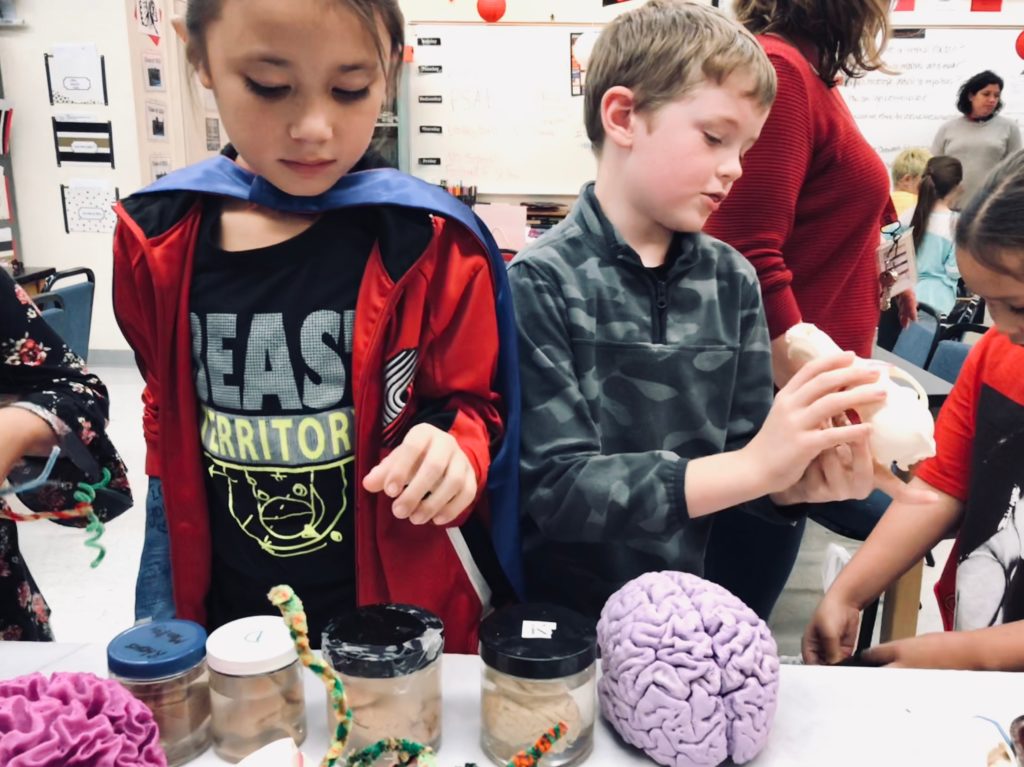“Haven’t you ever thought of living
unconsciously like bears, sniffing the earth,
close to pears and the mossy dark,
far from human voices and fire?”
– On İbrahim Balaban’s Painting “Spring”
― Nâzım Hikmet
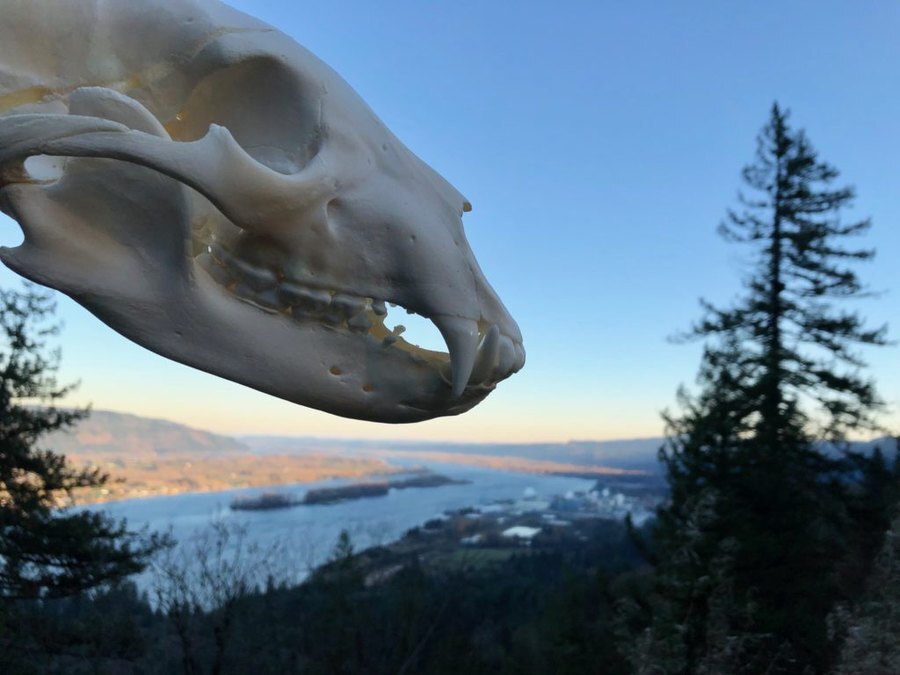
Black bear skull on Bradley Hill, Oregon
Earlier this year, thanks to Wayne Sherrard of Wayne’s Taxidermy in Yoncalla, Oregon, Noggin was offered the heads of multiple animals – including cougar, fox, badger, coyote and black bear – for our volunteer outreach in public schools…

LEARN MORE: Synapses & Stories: Coyote, Grizzly & their Brains!
LEARN MORE: Noggin Bloggin
Thanks to the enthusiasm (and Mopec saws!) of BioGift, we were able to dissect out skulls and reveal cerebrums, learning and communicating some fascinating facts, culture and history about the structure and function of these related animal brains…

“I profess to learn and to teach anatomy not from books but from dissections, not from the tenets of Philosophers but from the fabric of Nature.” –William Harvey
LEARN MORE: Adventure A-Head
LEARN MORE: COUGAR: THE AMERICAN LION
LEARN MORE: Darwinian natural selection: its enduring explanatory power
Dissection is a uniquely powerful technique for acquiring intimate, accurate and persistent knowledge of anatomy (and neuroanatomy) relevant to research, medicine, and a better understanding of the “fabric of Nature.”
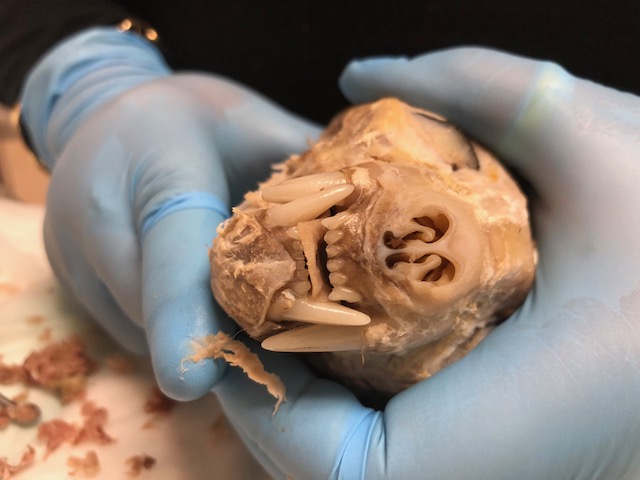
Badger head
Our Noggin volunteers worked hard to clean these gifted skulls, but our ability to scrape flesh and scour tissue from bone had its limits…

But Dermestid (or larder, or carpet) beetles have mad skills! These insects, which voraciously consume spoiled meat (though not fresh, or living tissue) have long been employed by taxidermists to prepare specimens, and have also found application in medicine and forensics…

Ravenous larder beetles will even consume flesh previously preserved in formaldehyde!
LEARN MORE: The Trickster in Bone
LEARN MORE: Use of Dermestid Beetles for Skeleton Preparation
LEARN MORE: Use of larder beetles (Coleoptera: Dermestidae) to deflesh human jaws
LEARN MORE: The use of insects in forensic investigations: An overview on the scope of forensic entomology
LEARN MORE: Estimation of Postmortem Interval Using Arthropod Development and Successional Patterns
LEARN MORE: Forensic Entomology in Criminal Investigations
![]()
Thanks to the tremendous generosity and expertise of Bob Bicknell, the owner of Beacon Hill Biological Services (“the largest osteological preparation firm in the West”) and SkullDuggery, in Toutle, WA, we now have some of the cleanest bear, cougar, badger and fox skulls around!
LEARN MORE: Toutle man uses beetles and bleach to build thriving skeletal business

Beetle-cleaned cougar skull on the Columbia!
“Tonight I am riddled by this thick skull
this white bowling ball zipped in the sad-sack carrying case of my face,
this overwound bone jack in the box,
this Orlando’s zero, Oaxacan offering; cabeza locada, calacear azucarada, clavo jodido, cenote of Mnemosyne,…”
–Natalie Diaz, from Dome Riddle (included in New Poets of Native Nations)
Have you ever considered the skull? Your own skull?
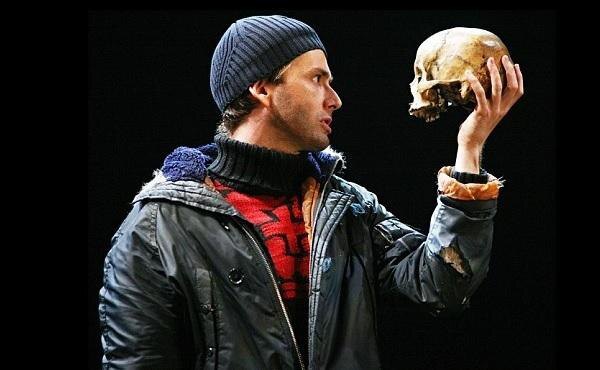
“Alas poor Yorick…” David Tennant as Hamlet with André Tchaikowsky‘s skull
LEARN MORE: The Composer Whose Skull Became a Real Human Stage Prop
Are you curious about how the 22 bones look, how they fit together, how they include holes, known as foramina, for nerves and blood vessels to pass through?
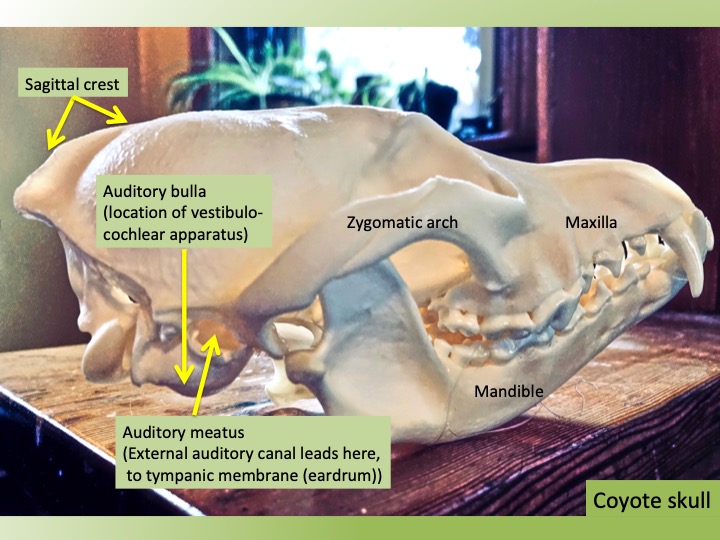
The large auditory meatus, for example, is part of the channel directing sound waves towards your tympanic membrane (a.k.a., your eardrum)! There is gripping architecture in the armor of living brains, and as always a close relationship between structure and function…
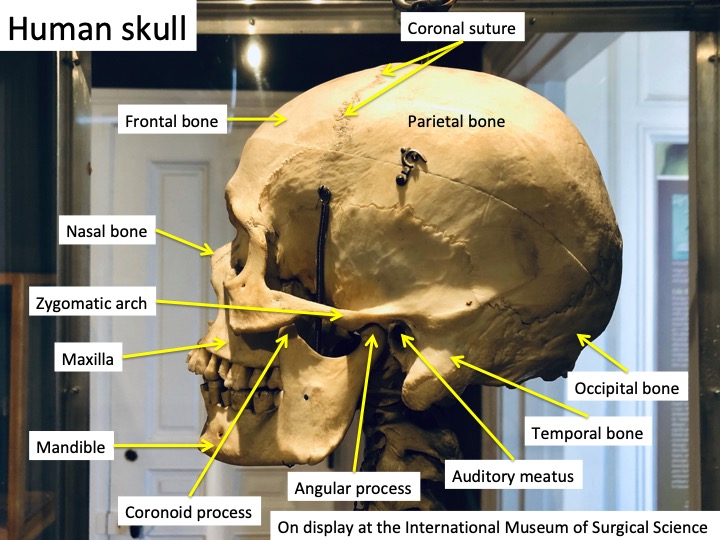
“We are biology. We are reminded of this at the beginning and the end, at birth and at death. In between we do what we can to forget.” ― Mary Roach. Human skull on display at the International Museum of Surgical Science, Chicago IL
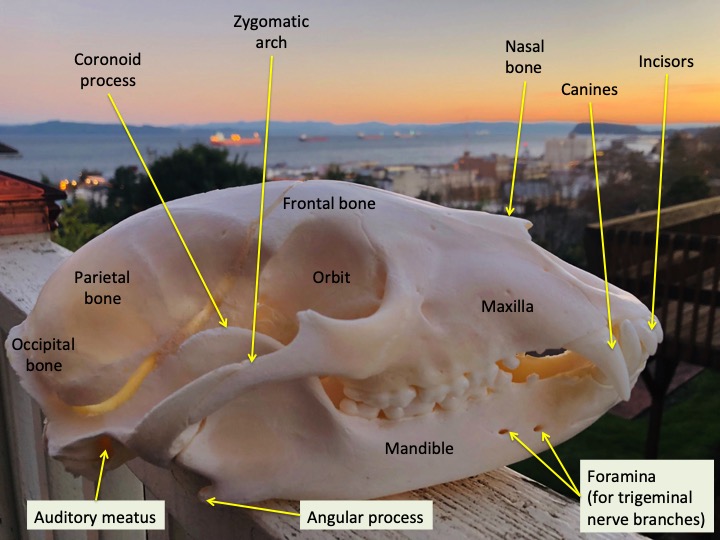
A lateral view of the Black Bear skull…
Feel your cheek bone (or zygomatic arch), clearly visible on the beetle-stripped skulls of both the cougar and black bear. Try moving your lower jaw (or mandible).

Human skull on display at the International Museum of Surgical Science
Chewing (mastication) requires the contraction of both the splayed out temporalis muscle, attached to the coronoid process, that shark fin-like mandibular protrusion behind each cheek (see the bear skull, above), and the masseter muscle, latched to the spiky angular process, which pulls your mandible upwards…
“Some of our parts
are more amenable to
the mechanical arts
than others; those that
articulate, in particular:
the less gluey, the
more angular, the levers
and pliers more than
the catch basin of juices
or cloud shaped organs
with vaguer and possibly
higher uses…”
–Kay Ryan

The enormous, powerful temporalis muscle of a Northwest cougar…
The maxilla is the upper jaw bone, holding the upper teeth, including some of the fearsome canines and incisors. More foramina are visible, and branches of another important cranial nerve (the trigeminal nerve) pass through to relay sensory information to your brain from your lower jaw. Your dentist may try to anesthetize these nerve branches (a mandibular block), but be warned – they sometimes cause damage with their needle..!
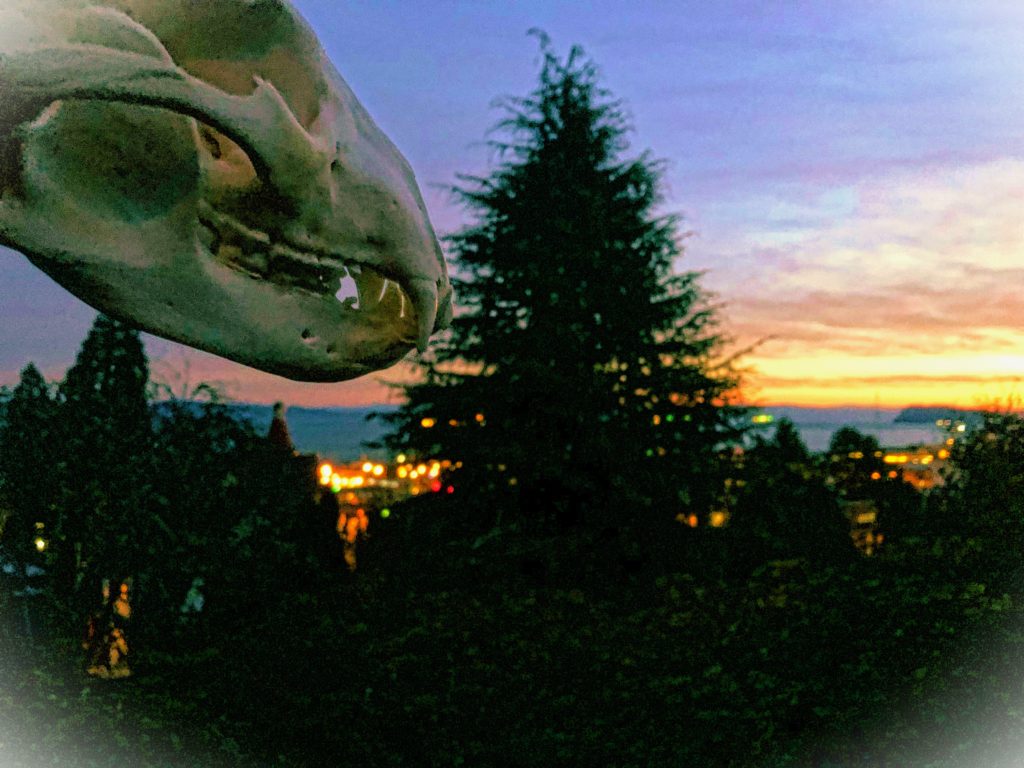
Bear zygomatic arch, coronoid process, maxilla and mandible over Astoria, Oregon
LEARN MORE: Injection Needle Injury of Oral Sensory Nerves

Some of the most visually striking bones are the fragile turbinates, the extraordinarily extensive series of maze-like olfactory channels beyond the nostrils of the bear (above) and cougar. Humans also have thin, bony turbinates, which increase the surface area for detecting the small, volatile chemicals we breathe in, known as odorants…
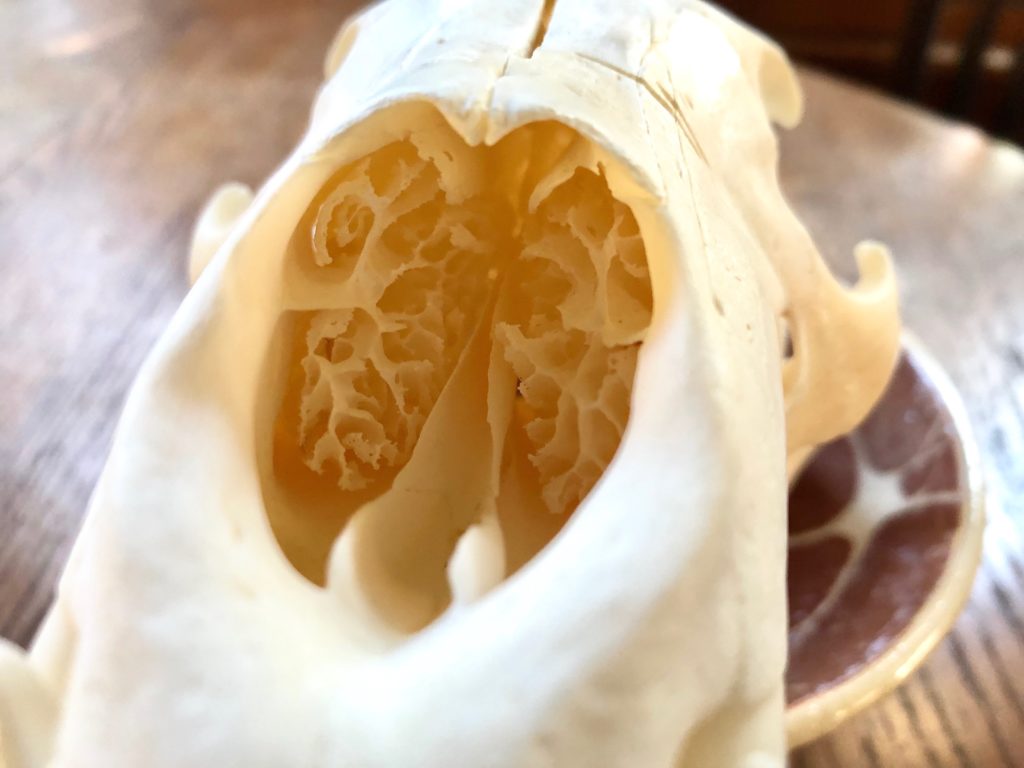
Turbinates of the black bear
But the turbinates are more elaborate in bears, cougars, badgers, coyotes and dogs, and also appear to differentially direct airflow, depending on whether the animal is breathing in, or out…
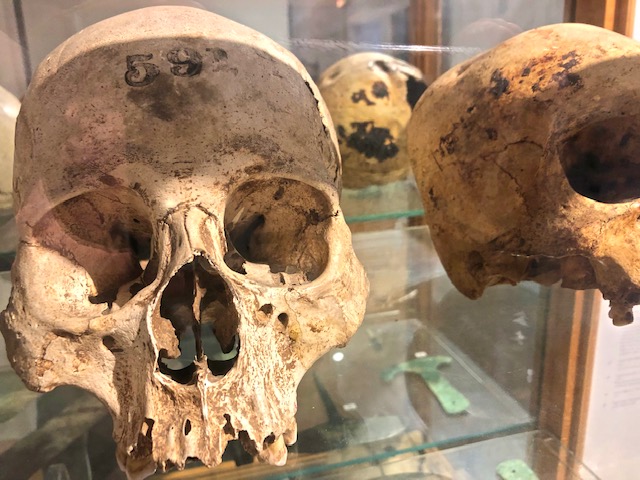
Human skulls on display at the International Museum of Surgical Science
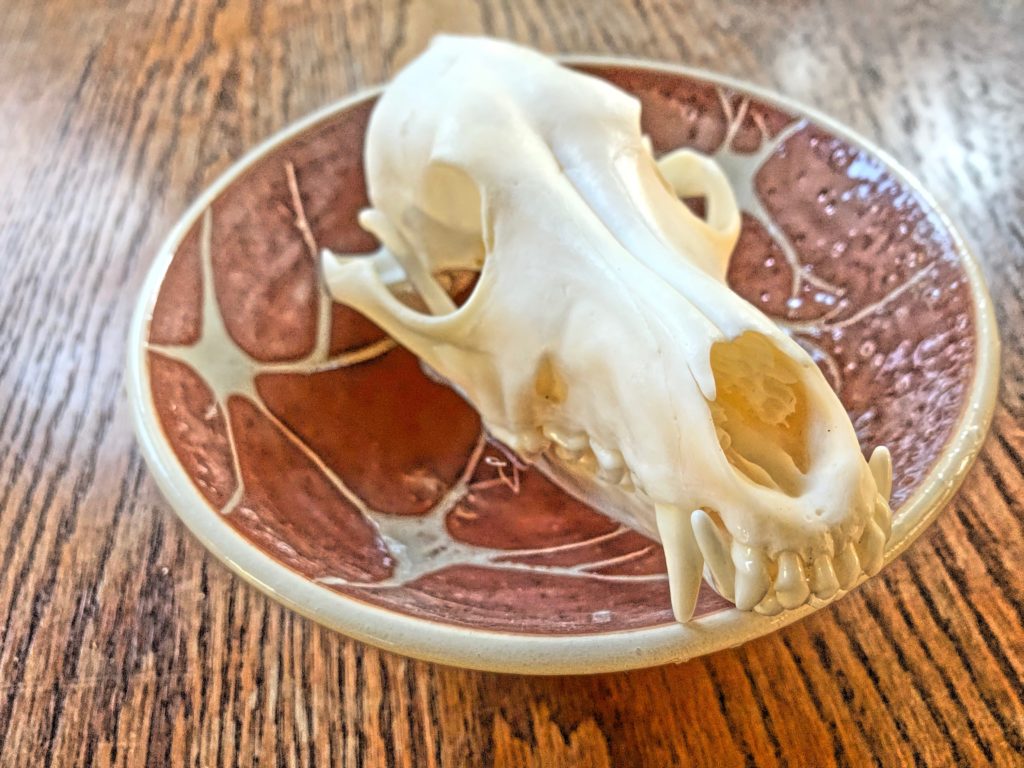
The skull of a coyote
LEARN MORE (much more!!): Adventure A-Head

It’s incredible to actually see the cribriform plate, a sieve-like part of the ethmoid bone which overlies the nasal cavity and its maze-like turbinates, pocked with holes (more foramina) for the wires of our olfactory neurons to project through our skull directly into our brain!


Neti pots on display at the International Museum of Surgical Science
LEARN MORE: Primary Amoebic Meningoencephalitis Caused by Naegleria fowleri: An Old Enemy Presenting New Challenges


ORDER YOUR OWN EMBROIDERED OLFACTORY SYSTEM: Embroidology
LEARN MORE: One landscape contains the other…
Then there are the delicate dividing wings (or alae) of the vomer bone, home to the vomeronasal (or Jacobsen’s) organ, where specialized sensory neurons bind odorants critical for motivated responses, including sexual arousal, known as pheromones.
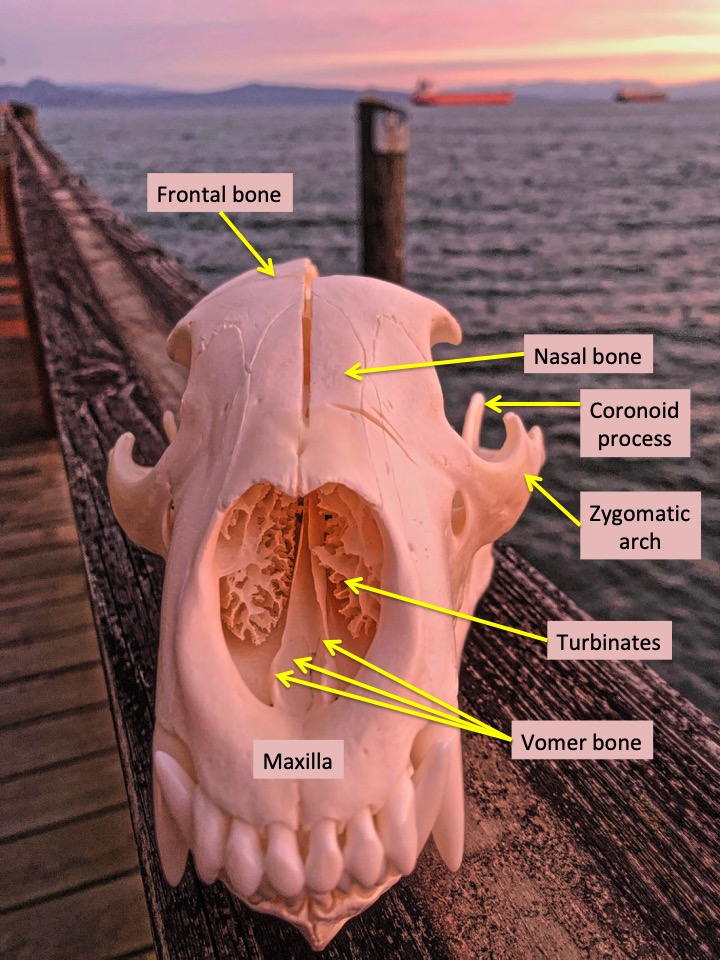
There is still debate over the existence and function of the vomeronasal organ in humans…
LEARN MORE: Learn more about Vomer
LEARN MORE: The Vomeronasal Organ: A Neglected Organ
LEARN MORE: Fate and Development of Human Vomeronasal Organ – A Microscopic Fetal Study
However, you might notice your dog, for example (also cats, goats, sheep, horses, cows,…) curl back their lips to expose their teeth, and inhale sharply over urine, poop or other items of intense interest.
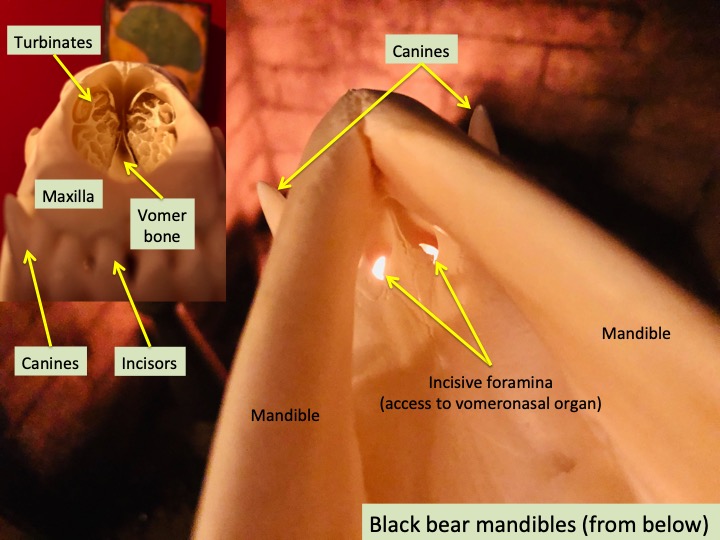
This is the Flehmen response, aimed at delivering pheromones to the sensory cells of the vomeronasal organ through the incisive foramina, ducts through the maxilla, just behind the incisors on the roof of the mouth.
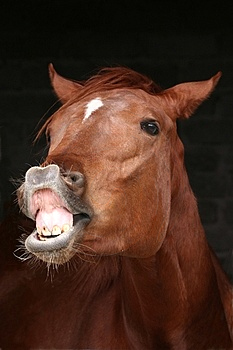
Flehmen response in a horse (Image Source)
LEARN MORE: The flehmen response of bulls and cows
LEARN MORE: The role of the Flehmen response in the behavioral repertoire of the stallion
LEARN MORE: Behavioral Responses to Mammalian Blood Odor and a Blood Odor Component in Four Species of Large Carnivores
LEARN MORE: Why Do Dogs, Cats, Camels, and Llamas Make That Weird Face?
Our thanks again to Wayne and Bob for generously donating and preparing these remarkable specimens for students to examine and consider. You inspire curiosity in a new generation for further exploration of the fabric of nature…
